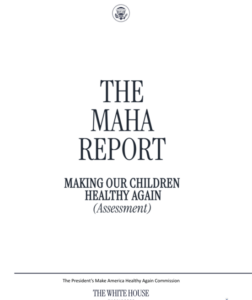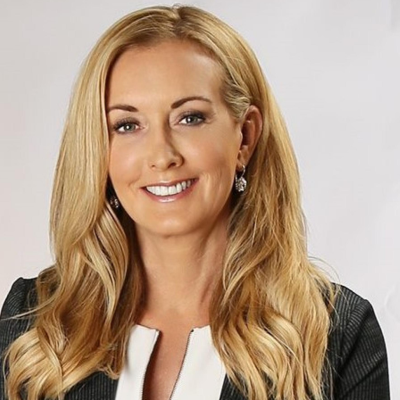Health advocates applaud MAHA report for calling out chemical harms, but say it falls short
Exposures to pesticides and other chemicals, ultra-processed foods and over-prescription of medications are among the factors contributing to an epidemic of chronic disease in America’s children, according to a government report issued Thursday by the Trump administration’s controversial “Make America Healthy Again” (MAHA) Commission.
The 68-page assessment calls for a “transformation” of US food, health and “scientific systems” as a means to address what the report calls the “sickest generation in American history in terms of chronic disease”.
The report blames complacency in scientific and medical institutions, corrupted federal and state policies guided “more by corporate profit than the public interest,” and US food and agricultural systems that have “embraced ultra-processed ingredients and synthetic chemicals.” The report specifically calls out corporate influence over research, regulators and lawmakers as factors contributing to the problems.
The commission’s work, led by Health and Human Services Secretary Robert F. Kennedy Jr., has been under close scrutiny and generated controversy even before it was released amid expectations that it might highlight health concerns linked to powerful industry interests, including the use of toxic pesticides in agriculture.
Public health advocates had mixed reactions to the report, applauding many of the key points and cheering the fact that the report targets topics that past administrations have avoided. Some, though, wished the report had gone farther, and said industry pressure likely helped suppress any meaningful policy change recommendations.
 “While I support and applaud the MAHA focus on chronic diseases affecting our children, it is disheartening that it took us decades to get here,” said Michelle Perro, a pediatrician, author and activist for children’s health. “The environmental toxic impacts on our children’s well-being has been known for decades, but not acted upon until now.”
“While I support and applaud the MAHA focus on chronic diseases affecting our children, it is disheartening that it took us decades to get here,” said Michelle Perro, a pediatrician, author and activist for children’s health. “The environmental toxic impacts on our children’s well-being has been known for decades, but not acted upon until now.”
Pressure over pesticides
Before his appointment to HHS, Kennedy was a vocal opponent of pesticide use in farming, and was involved in litigation against Monsanto and its German owner Bayer over their manufacturing and marketing of the world’s most widely used herbicide, a chemical called glyphosate that has been declared a probable human carcinogen by cancer experts at the World Health Organization.
The commission report spotlights glyphosate, the key ingredient in the popular Roundup brand, citing “a selection of research studies” that have noted a “range of possible health effects, ranging from reproductive and developmental disorders as well as cancers, liver inflammation and metabolic disturbances.”
The report additionally cites concerns with the weed killer atrazine, also used widely in farming, including research linking atrazine to endocrine disruption and birth defects.
Leading agricultural associations preemptively pushed the commission to keep pesticide concerns out of the report, saying concerns about negative health impacts are not valid. Several of the largest and most powerful farm organizations, including the National Corn Growers Association and the American Soybean Association warned ahead of the report that if the commission raised concerns about “production practices” such as pesticide use, the actions could “put American food production at risk.”
Additionally, raising such concerns could jeopardize the livelihoods of hundreds of thousands of US farmers, the farm groups warned.
Heath experts said the evidence of pesticide dangers is decades old, and the farm lobby is trying to protect its interests at the expense of public health.
“I chaired a 1993 report at the National Academy of Sciences, which documented very clearly that pesticides can cause disease in humans, and that infants and children are especially vulnerable to these effects,” said Dr. Philip Landrigan, a pediatrician, epidemiologist and director of the Global Observatory on Planetary Health at Boston College. “In the more than 30 years since that time, the evidence that pesticides can cause disease and death has only strengthened. These are not benign chemicals.”
The report tread carefully around the pesticide issue, echoing industry statements that “precipitous changes”, such as restrictions on pesticides, could have an “adverse impact” on farmers and the food supply.
The report falls “woefully short” of what is needed to protect children’s health, according to George Kimbrell, legal director of the Center for Food Safety.
“The MAHA commission recognizes that the overuse of pesticides in America’s industrial food system is a critical piece of the nation’s health crisis and acknowledges the now well-established scientific evidence of the dire harm these toxins are causing children, public health, and the environment,” Kimbrell said in a statement. “However, the report falls woefully short of providing any next steps … Much more is required – and urgently – in order to meaningfully address the twin public health and environmental crises we face. Protecting children’s health and building a healthy food system must trump pesticide corporations’ profits.”
In addition to pesticide exposure, US children are exposed regularly to synthetic chemicals through myriad routes, including their diet, household products and the air they breathe, the report makes clear.
The cumulative load of exposures to those thousands of synthetic chemicals “may pose risks to their long-term health, including neurodevelopmental and endocrine effects.” Children are particularly vulnerable to chemicals during critical stages of development, including before they are born, and during infancy, early childhood, and puberty, the report states.
Environmental Protection Agency Administrator Lee Zeldin said in a statement that the agency would work to “protect human health and the environment while fulfilling all of our statutory obligations to safely regulate chemicals needed for every part of modern life to transport, build, feed, and power the Great American Comeback.”
Corporate influence and cover ups
The report dedicates one section to a plague of corporate influence, highlighting research that points out that a “significant portion” of the research conducted to inform regulation of chemicals is done by the companies profiting from the chemicals, and that analyses of that research shows “potential biases.”
The report cites as an example internal industry records that have revealed the makers of toxic per- and polyfluoroalkyl substances (PFAS) “focused on suppressing unfavorable research and distorting public discourse, effectively delaying public awareness of [PFAS] dangers.”
PFAS exposure has been associated with a variety of health effects, including immune suppression, the report point out.
“Corporate influence stretches beyond extensive involvement in scientific research to include active governmental lobbying,” the report states, noting that last year, the chemical-manufacturing lobby spent roughly $77 million on “federal influence activities,” placing the industry among Washington’s top spenders. And in 2023, 60% of chemical-sector lobbyists previously held federal posts, according to the report.
“As a result of this influence, the regulatory environment surrounding the chemical industry may reflect a consideration of its interests. For example, more than ten thousand chemicals listed on EPA’s inventory are designated as confidential and generic chemical names are used to identify them,” the report states.
Tracey Woodruff, director of the Program on Reproductive Health and the Environment at the University of California San Francisco, said it was “amazing” to see official government recognition not only of the harms of chemicals, but of the corporate influence that has stifled regulation.
“Finally, the federal government is acknowledging these things,” Woodruff said. “They actually say toxic chemicals are part of the problem with children’s health. I don’t think this administration is going to solve these issues and actually regulate toxic chemicals. But now that this has been recognized by this White House, it’s not going to go back in the bottle.”
Woodruff noted that in contrast to the call to protect children’s health coming from MAHA, the Trump administration has been aggressively rolling back environmental regulations, which will continue to “allow polluters to spew toxic chemicals.”
An “alarming trajectory”
In establishing the commission and calling for the MAHA commission assessment, the White House cited data marking an “alarming trajectory that requires immediate action,” including statistics showing that among more than 200 countries and territories, the US had the highest age-standardized incidence rate of cancer in 2021 and experienced an 88% increase in cancer from 1990-2021, the largest percentage increase of any country evaluated.
For children, 2022 data shows more than 40% of the country’s youth – roughly 30 million – suffered from at least one chronic health problem, with nearly 30% of adolescents prediabetic. More than 3.4 million children are medicated for attention deficit disorders, with diagnoses continuing to climb, the White House states.
The MAHA report does not exclusively blame chemicals, but also cites health problems associated with diets heavily reliant on ultra-processed foods containing harmful additives; a lack of physical activity that has led to a decline in fitness; chronic stress; inadequate sleep; common consumptions of prescription medicines that include stimulants and antidepressants; and an increase over the last 40 years in the number of government-recommended vaccines.
The report calls for multiple new research initiatives to “close critical research gaps” and guide policy changes.
“To turn the tide and better protect our children, the United States must act decisively,” the report states. “During this administration, we will begin reversing the childhood chronic disease crisis by confronting its root causes-not just its symptoms. This means pursuing truth, embracing science, and enacting pro-growth policies and innovations to restore children’s health. Today’s children are tomorrow’s workforce, caregivers, and leaders—we can no longer afford to ignore this crisis.”
(Featured image by Getty Images for Unsplash +.)




